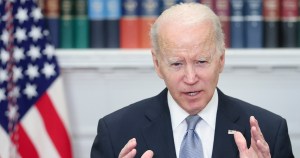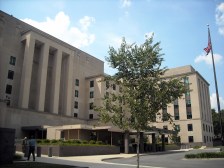CIO Council reinvigorates IT workforce discussion
Two chief information officers have breathed new life into the CIO Council’s once-lapsed Workforce Committee.
Transportation CIO Richard McKinney and Nuclear Regulatory Commission CIO Darren Ash assumed roles as co-chairs of the committee early last year. In 2015, the two have big plans for the Workforce Committee, starting with sparking conversation about the current IT workforce with the results of a recent survey.
Completed in February, the data collection was less a scientific effort and more a baseline to analyze the IT hiring process around the government. McKinney and Ash told FedScoop the committee focused on two main elements in the study: hiring time and quality of hires. Results, they said, were mixed.
“When we aggregated the numbers, we had a range of experience from some agencies and departments where the hiring process was in a fairly reasonable time frame, fairly quick time frame, and for others it was more protracted,” McKinney said, noting that government was quite responsive to the committee’s efforts.
Ash said it was also important to measure how talented new IT applicants and hires were.
“I think that gets to a broader challenge: When we post a position out there on USAjobs.gov, we get a lot of applicants, which is great — you get a strong pool of diverse candidates,” he said. “But the challenge is always going to be, how many of them are well qualified?” Again results were mixed with some positive and some negative response.
The co-chairs didn’t offer solid numbers; the study, they maintained, was unscientific. What it was meant to do, however, was stimulate “a very robust conversation that’s taking place between the CIO community and the chief human capital officers community,” McKinney said, adding that the data will be “a map toward where these conversations should take us.”

Transportation Department CIO Richard McKinney (CIO Council)
Under the E-Government Act of 2002, the CIO Council is tasked to work with the Office of Personnel Management “to analyze the personnel needs of the Federal Government related to IT and information resource management” and “identify where current training does not satisfy current personnel needs, and then issue policies to promote development of performance standards for training.” The key to this is coordination between agency CIOs and CHCOs.
That’s where McKinney said they’ll take the results of this survey.
“We’re going to use some of these surveys to sit down with the folks in the CHCO community and say, ‘Hey, can you help us figure out these processes, are there ways to tweak them and improve them?'” he said. Within that, Ash questioned, “do we need better hiring authorities?” like Veterans Preference and Schedule A to get quality talent hired quicker.
Improved communication between the CIO and CHCO offices, the two believe, will lead to stronger job listings and more effective hires.
“The true partnership is at the hiring manager level with the HR specialist,” Ash said. “It’s that communication about ‘Are we being clear enough, are we being concise enough in terms of describing what the job requirements are for a position description?’ We always talk about where the rubber hits the road, and that’s the key point: to make sure things are very clear.”
‘Mission’ sets federal jobs apart
Hiring is just one issue surrounding the federal IT workforce; the committee is also looking to improve recruitment, training and maintenance of IT talent. And competing with the private sector for IT talent is often cited as the federal IT workforce’s biggest challenges.
“We’re in heavy competition with the private sector for talented folks. So we want to make sure our processes and all make it where we can have the best end result and get the talent in here that we need,” McKinney said, noting that things like salary make it “not easy to compete.” But the federal government has other incentives to offer, and the CIO Council wants to emphasize those.
“There are people, and I meet them everyday and I work with them everyday, who very much like the IT environment of the public sector and are proud to work in public service and want to make public service their career,” he said. “And I think the way we nurture that is make sure we’re training our folks and giving them opportunities and challenging them and making sure that we as CIOs understand” employees’ needs. “It’s something that all CIOs want, to make sure that we invest in our people,” McKinney said.
Ash said mission is the biggest thing that sets government work apart. “There’s something about an organization’s mission, its importance, how it resonates, and the impact that individual has on the program,” he said. “I think that’s an important thing you don’t get everywhere.”
McKinney and Ash have several initiatives planned for the upcoming year that focus on nurturing the current workforce and attracting new additions.
In April, the CIO Council will sponsor the Association for Federal Information Resources Management’s Federal IT Career Workshop and Shadow Day. The event aims to attract college students to hear about federal IT career opportunities. During it, students will have the chance to schedule a day shadowing a federal IT professional.
A two-day IT symposium is also in the works, and so is a survey to analyze IT skills gaps.
“This committee is really starting to gain momentum,” McKinney said. “It took us a while to re-establish it and get going … but of late, I look toward 2015, and I see a pretty full plate of events and initiatives that we’re taking on.”
That full agenda, they hope, will begin to help the federal government address workforce challenges related the rapid evolution of IT.
“The pace of change means that there is a strong need for talent, a particular talent that we don’t have enough of,” Ash said. “I think that’s a recognition that agencies need good talent, strong talent, to help us fulfill our missions.”




